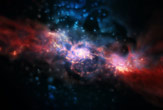One Star Birth Scenario Debunked By 'Fossil' Galaxies

The discovery of what scientists call "living fossil" galaxies afflicted with cosmic turbulence is shedding light on how stars are born.
In the study, astronomers investigated a set of rare, relatively modern galaxies that have the same type of unusual turbulence found in more ancient galaxies. [Photo of star-forming galaxy.]
“They’re living fossils of space – galaxies we just didn’t expect to find in today’s world,” said study co-author Andrew Green, an astronomer with Swinburne University in Australia, in a statement.
The findings could shed new light on the persisting mystery of star formation, astronomers said.
something about how stars form," Green told SPACE.com. "Despite the fact that we live in a galaxy, the Milky Way, and we live next to a star, our sun, we still have a very poor idea of how galaxies form and evolve and how stars form from primordial gas. Now we think we might have found a link between star formation and this galactic turbulence."
In the early universe, two-thirds of all galaxies were massive, rotating disks. Mysteriously, wind speeds within these ancient galaxies were five times more variable than in today's disk galaxies.
Scientists had bandied about several causes for such turbulence. Perhaps extra gas or dwarf galaxies that were more common in the early universe stirred up the massive disks as they fell into them, drawn by their gravity.
Get the world’s most fascinating discoveries delivered straight to your inbox.
To settle the question, Green and his colleagues investigated 65 modern-day star-forming galaxies within roughly 1 billion light-years of Earth. One light-year is the distance light travels in a single year, about 6 trillion miles (10 trillion km).
They found 11 modern galaxies with wind speeds as variable as those seen in older, massive galaxies.
Matter falling into the galaxies could not account for such turbulence as it might with ancient disks — all that extra gas and those dwarf galaxies had largely been absorbed by other galaxies in the intervening time, the researchers said.
Instead, Green, his supervisor and co-author Karl Glazebrook, and their colleagues found the level of this variability in wind speed was linked to star-forming rates. This suggests the energy released by newly formed stars drives galactic turbulence both then and now.
"It's entirely possible that all spiral galaxies, including the Milky Way, went through a stage in the past when they had high star formation rates and associated high turbulence," Green said.
The scientists detailed their research in the Oct. 7 issue of the journal Nature.
- Top 10 Star Mysteries
- Hubble Telescope Photos: When Galaxies Collide
- Recently Discovered Phenomenon Could Reveal How Stars Are Born
covered Phenomenon Could Reveal How Stars Are Born



